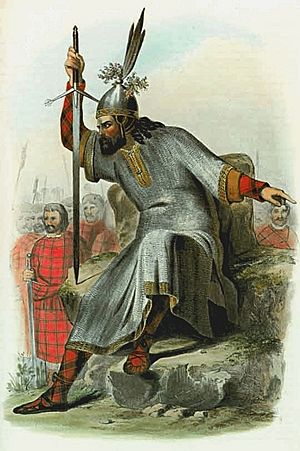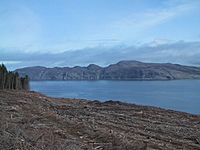John of Islay, Earl of Ross facts for kids
Quick facts for kids John of Islay |
|
|---|---|
| Earl of Ross and Lord of the Isles | |
| Reign | 1449–1476/1493 |
| Predecessor | Alexander of Islay |
| Born | 1434 |
| Died | 1503 Dundee |
| Burial | Either Scone or Paisley Abbey |
| Spouse | Elizabeth Livingstone |
| Issue | Angus Óg |
| House | Clan Donald |
| Father | Alexander of Islay |
| Mother | Elizabeth Seton |
John of Islay (also known as John MacDonald) lived from 1434 to 1503. He was a very important person in Scotland during the late Middle Ages. John was the fourth and last Lord of the Isles, and the chief of Clan Donald.
He was involved in a big power struggle with James III of Scotland, the King of Scotland. This fight was mainly over control of the western parts of Scotland, which used to be ruled by the Norse (Vikings). John's defeat led to a rebellion against him by his son, Angus Óg. This rebellion included a major sea battle called the Battle of Bloody Bay. After this, John lost much of his power. The Lordship of the Isles officially ended in 1493 under King James IV.
Contents
Early Life of John of Islay
John was born in 1434. His father was Alexander of Islay, who was the Earl of Ross and Lord of the Isles. His mother was Elizabeth Seton.
John became the leader of his father's lands in 1449. He was still quite young at the time.
John's Marriage to Elizabeth Livingstone
John's marriage to Elizabeth Livingstone was arranged for political reasons. This was common for important families back then. John came from a powerful family with lots of land. Elizabeth's father, Sir James Livingstone, was a strong politician. However, his power was personal, not based on land.
John always wanted more land and power. He did not get along well with Elizabeth.
Rebellion Against the King of Scotland

After some trouble, Sir James Livingstone found safety with John. John then started a rebellion against the King. He took over royal castles like Inverness, Urquhart, and Ruthven. This showed the King how powerful John was in the north.
Allies and Treaties with Other Nobles
John's rebellion happened when King James II was having problems with the Earl of Douglas. The Earl of Douglas was the most powerful noble in southern Scotland. John, Douglas, and Alexander Lindsay, 4th Earl of Crawford made an agreement. They promised to support each other against everyone, even the King.
King James II saw this as a threat to his rule. He met with the Earl of Douglas in 1452. The King demanded that Douglas break their agreement. Douglas refused, and the King ended up killing him.
John did not seem too worried about what happened to Douglas. His relationship with the King actually got better. John did not stop the King from defeating the Douglas family in 1455. He even gained some land from them.
A Dangerous Proposal from England
In 1460, King James II died suddenly. His son, James III, became king. Soon after, John received a proposal that would cause him many problems later.

At this time, England was in a civil war. King Henry VI had been forced out by Edward IV. Henry took refuge in Scotland. King Edward IV then sent the exiled Earl of Douglas to meet with John.
At his castle of Ardtornish, John agreed to send his representatives to London. This was a risky move. While past Lords of the Isles had contact with England, they never went this far. England had also never truly helped the Lordship when it was in trouble with Scotland. It should have been clear that Edward IV was just trying to cause problems for Scotland.
The Treaty of Westminster-Ardtornish
In February 1462, John's representatives signed an agreement. It was called the Treaty of Westminster-Ardtornish. This treaty planned for England to help John conquer and divide Scotland. John agreed to respect Edward IV as his overlord. In return, he would get all of Scotland north of the Forth River.
The treaty was not very clear about how much help England would give. But for Edward IV, it was a great success. He caused trouble in Scotland without spending much.
Even before the treaty was finished, John's men started fighting. His son, Angus Óg, led them east. They captured Inverness again. People in the north were told not to obey King James III.
This rebellion had the effect Edward IV wanted. The Scottish government faced trouble in the north. They also feared an attack from England. So, they stopped supporting Henry VI. John realized the treaty was not very helpful. He backed down and admitted his actions were wrong. For now, no more action was taken against him.
Angus Óg and the Battle of Bloody Bay
In the mid-1470s, King Edward IV of England revealed the full terms of the Westminster treaty. He was preparing for a war with France and wanted good relations with Scotland. John was called to the Scottish Parliament to answer for his actions. When he did not show up, he was declared to have lost his lands and titles.
John had no allies left. He had to make peace with the King in 1476. Even though his actions were serious, he was treated quite fairly. He lost the Earldom of Ross and the Isle of Skye. He also lost Knapdale and Kintyre. However, he kept control of the Hebrides. From then on, the title of Lord of the Isles had to be given by the King, not just claimed.
But John had lost more than land. He lost respect among his own family and followers. The Lordship of the Isles had always grown by taking more land. Now that it was shrinking, old problems came out. These problems showed up in his son, Angus Óg.
Angus Óg took over leadership of the clan from John. He even forced John out of his own home. This started a bitter civil war. John managed to gather his own army and fleet of ships. His fleet met Angus's fleet in the early 1480s. The battle happened off the coast of Mull, near where Tobermory is today. This area became known as Bloody Bay.
The Battle of Bloody Bay was a complete victory for Angus Óg. He continued to lead Clan Donald until he was killed in 1490.
The End of the Lordship
After the Battle of Bloody Bay, John's power was greatly reduced. He could no longer keep peace in the western parts of Scotland. Divisions grew, and the end of the Lordship was near.
In 1490, John's son, Angus Óg, was killed by his Irish harper. After Angus's death, John tried to regain some power. However, he was not a strong leader. He gave the Lordship of the Isles to his nephew, Alexander Lochalsh.
Alexander tried to take back control of the Earldom of Ross. But he was defeated by the Mackenzies at the Battle of the Park. In 1493, the Scottish Parliament, led by King James IV of Scotland, officially ended the independent Lordship of the Isles.
John spent the rest of his life in the Lowlands of Scotland. He received money from the King. He died in Dundee in 1503. It is believed he was buried at Scone, next to his royal ancestor, Robert II.
The final step came in 1540. King James V officially made Islay and the other Isles part of the Crown lands.
John of Islay's Legacy
It is hard to fully understand John of Islay. He was the leader who saw the end of a great family power. He seemed to have different qualities. Sometimes he was strong and proud. Other times, he was weak and gave in easily.
One historian of Clan Donald described him as a "meek, modest man." He also said John was "a scholar more fit to be a churchman than to command so many irregular tribes of people."
John had children born outside of marriage:
- John Macdonald
- Margaret Macdonald. She married Kenneth Mackenzie.
- Aonghas Óg Macdonald. He married Lady Mary Campbell. He was killed in 1490.


